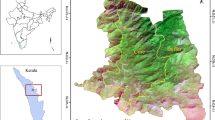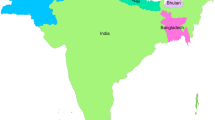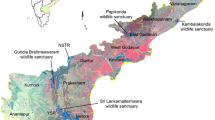Abstract
Analyzing the spatial extent and distribution of forest fires is essential for sustainable forest resource management. There is no comprehensive data existing on forest fires on a regular basis in Biosphere Reserves of India. The present work have been carried out to locate and estimate the spatial extent of forest burnt areas using Resourcesat-1 data and fire frequency covering decadal fire events (2004–2013) in Similipal Biosphere Reserve. The anomalous quantity of forest burnt area was recorded during 2009 as 1,014.7 km2. There was inconsistency in the fire susceptibility across the different vegetation types. The spatial analysis of burnt area shows that an area of 34.2 % of dry deciduous forests, followed by tree savannah, shrub savannah, and grasslands affected by fires in 2013. The analysis based on decadal time scale satellite data reveals that an area of 2,175.9 km2 (59.6 % of total vegetation cover) has been affected by varied rate of frequency of forest fires. Fire density pattern indicates low count of burnt area patches in 2013 estimated at 1,017 and high count at 1,916 in 2004. An estimate of fire risk area over a decade identifies 12.2 km2 is experiencing an annual fire damage. Summing the fire frequency data across the grids (each 1 km2) indicates 1,211 (26 %) grids are having very high disturbance regimes due to repeated fires in all the 10 years, followed by 711 grids in 9 years and 418 in 8 years and 382 in 7 years. The spatial database offers excellent opportunities to understand the ecological impact of fires on biodiversity and is helpful in formulating conservation action plans.










Similar content being viewed by others
References
Bahali, D. D., Agrawala, D. K., & Chowdhery, H. J. (1998). Similipal tiger reserve. In P. K. Hajra, M. Gangopadhyay, & T. Chakraborty (Eds.), Plant diversity in tiger reserves of India (pp. 418–439). Kolkata: Botanical Survey of India.
Brandis, D. (1882). The forests of South India. Indian Forester, 7, 363–369.
Bucini, G., & Lambin, E. F. (2002). Fire impacts on vegetation in Central Africa: a remote-sensing-based statistical analysis. Applied Geography, 22, 27–48.
Champion, H. G., & Seth, S. K. (1968). A revised survey of forest types of India. New Delhi: Manager Publications, Government of India.
Chand, K. T. R., Badarinath, K. V. S., Prasad, K. V., Murthy, M. S. R., Elvidge, C. D., & Tuttle, B. T. (2006). Monitoring forest fires over the Indian region using DMSP-OLS nighttime satellite data. Remote Sensing of Environment, 103, 165–178.
Chape, S., et al. (2005). Measuring the extent and effectiveness of protected areas as an indicator for meeting global biodiversity targets. Philosophical Transactions of the Royal Society: Biological Sciences, 360, 443–455.
Chavez, P. S. (1996). Image-based atmospheric corrections — revisited and improved. Photogrammetric Engineering and Remote Sensing, 62, 1025–1036.
Chirici, G., & Corona, P. (2005). An overview of passive remote sensing for post-fire monitoring. Forest@, 2(3), 282–289. http://www.sisef.it/. [Online].
Eva, H., & Lambin, E. F. (1998). Burnt area mapping in Central Africa using ATSR data. International Journal of Remote Sensing, 19, 3473–3497.
FAO. (2003).http://www.fao.org/english/newsroom/news/2003/21962-en.html. Accessed 13th February 2013).
FAO. (2010). Global forest resources assessment (2010). FAO Forestry Paper 163. Rome, Italy: Food and Agriculture Organization. http://www.fao.org/docrep/013/i1757e/i1757e.pdf. Accessed 14th November 2012.
FSI. (1995). State of forest report. Ministry of Environment and Forests, Govt. of India.
Giriraj, A., Shilpa, B., Jentsch, A., Sudhakar, S., & Murthy, M. S. R. (2010). Tracking fires in india using advanced along track scanning radiometer (A) ATSR data. Remote Sensing, 2, 591–610.
Harikrishna, P., & Reddy, C. S. (2012). Assessment of increasing threat of forest fires in Rajasthan, India using multi-temporal remote sensing data (2005–2010). Current Science, 102(9), 1288–1297.
Hiremath, A. J., & Sundaram, B. (2005). The fire-lantana cycle hypothesis in Indian forests. Conservation and Society, 3(1), 26–42.
Holl, K. D., & Aide, T. M. (2011). When and where to actively restore ecosystems? Forest Ecology and Management, 261(10), 1558–1563.
IPCC. (2007). Fourth assessment report of the intergovernmental panel on climate change. Cambridge: Cambridge University Press.
Joseph, S., Anitha, K., & Murthy, M. S. R. (2009). Forest fire in India: a review of the knowledge base. Journal of Forestry Research, 14, 127–134.
Kodandapani, N. (2013). Contrasting fire regimes in a seasonally dry tropical forest and a savanna ecosystem in the Western Ghats, India. Fire Ecology, 9(2), 102–115. doi:10.4996/fireecology.0902102.
Kodandapani, N., Cochrane, M. A., & Sukumar, R. (2004). Conservation threat of increasing fire frequencies in the Western Ghats, India. Conservation Biology, 18, 1553–1561.
Liu, J., Linderman, M., Ouyang, Z., An, L., Yang, J., & Zhang, H. (2001). Ecological degradation in protected areas: the case of Wolong Nature Reserve for Giant Pandas. Science, 292, 98–101.
Mathur, V. B., & Ghosh, S. (2002). Developing spatial strategies for using prescribed burning as a tool in wildlife protected areas. Department of Space, Govt. of India. NNRMS Bulletin, 27, 42–48.
Meher-Homji, V. M. (2001). Bioclimatology and plant geography of peninsular India. Jodhpur, India: Scientific Publishers.
Palni, L. M. S., Rawal, R. S., Rai, R. K., & Reddy, S. V. (2012). Compendium on Indian biosphere reserves- progression during two decades of conservation. Uttarakhand: G.B. Pant Institute of Himalayan Environment & Development. Ministry of Environment and Forests, Government of India.
Reddy, C. S., Pattanaik, C., Mohapatra, A., & Biswal, A. K. (2007). Phytosociological observations on tree diversity of tropical forest of Similipal Biosphere Reserve, Orissa, India. Taiwania, 52(4), 352–359.
Reddy, C. S., Harikrishna, P., Anitha, K., & Joseph, S. (2013). Mapping and inventory of forest fires in Andhra Pradesh. India: Current status and conservation needs. ISRN Forestry. doi:10.5402/2012/380412.
Sabins, F. F. (1987). Remote sensing: principles and interpretation. New York: W.H. Freeman.
Saha, S. (2002). Anthropogenic fire regime in a deciduous forest of central India. Current Science, 82, 1144–1147.
Saha, S., & Howe, H. F. (2003). Species composition and fire in a dry deciduous forest. Ecology 84, 3118–3123.
Salem, B. B. (2003). Application of GIS to biodiversity monitoring. Journal of Arid Environments, 54, 91–114.
Sasaki, N., & Putz, F. E. (2009). Critical need for new definitions of “forest” and “forest degradation” in global climate change agreements. Conservation Letters, 2(5), 226–232.
Saxena, H. O., & Brahmam, M. (1989). The flora of Similipahar, Orissa. Bhubaneswar, India: Regional Research Laboratory.
Singh, T. P., Singh, S., Roy, P. S., & Rao, B. S. P. (2002). Vegetation mapping and characterization in West Siang District of Arunachal Pradesh, India — a satellite remote sensing-based approach. Current Science, 83(10), 1221–1230.
Sringeswara, A. N., Shivanna, M. B., & Gowda, B. (2012). Forest fire and its management in Kudremukh National Park, Western Ghats, India using remote sensing and GIS (13th ESRI India User Conference 2012). India: ESRI.
Somashekar, R. K., Ravikumar, P., Kumar, C. M., Prakash, K. L., & Nagaraja, B. C. (2009). Burnt area mapping of Bandipur National Park, India using IRS 1C/1D LISS III data. Journal of the Indian Society of Remote Sensing, 37(1), 37–50.
Thompson, I. D., Guariguata, M. R., Okabe, K., Bahamondez, C., Nasi, R., Heymell, V., et al. (2013). An operational framework for defining and monitoring forest degradation. Ecology and Society, 18(2), 20.
UNESCO. (2008). Madrid action plan for biosphere reserves (2008–2013). Paris: UNESCO.
Acknowledgments
The work has been carried out under national project “Inventorization and monitoring of biosphere reserves in India using remote sensing and GIS technology,” supported by the Ministry of Environment and Forests, Government of India. The authors are thankful to Dr. V.K. Dadhwal, Director, NRSC for encouragement and the Chief Wildlife Warden and Field Director, Similipal Biosphere Reserve, Odisha Forest Department for permission and facilities to carry out the field work.
Author information
Authors and Affiliations
Corresponding author
Rights and permissions
About this article
Cite this article
Saranya, K.R.L., Reddy, C.S., Rao, P.V.V.P. et al. Decadal time-scale monitoring of forest fires in Similipal Biosphere Reserve, India using remote sensing and GIS. Environ Monit Assess 186, 3283–3296 (2014). https://doi.org/10.1007/s10661-014-3619-7
Received:
Accepted:
Published:
Issue Date:
DOI: https://doi.org/10.1007/s10661-014-3619-7




